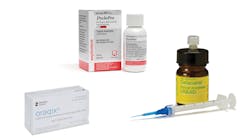Topical storm? The dental hygienist’s guide to topical anesthetics
Pain is a powerful motivator and demotivator for patients to seek treatment from their dental hygienist. Unfortunately, pain, or the fear of pain, keeps some of our patients from seeing us. While this certainly applies to postprocedural pain, we cannot overlook the impact of periprocedural pain on patients’ perceptions of overall pain as part of their dental hygiene experience. Here, I’ll focus specifically on the use of topical anesthetics as adjuncts in the management of patients’ periprocedural pain and fear.
Injectable versus topical anesthetics
Proper management of dental pain and fear is essential to ensure our patients’ therapeutic success. The administration of local anesthesia by injection is an important component of adequate pain management and hemostasis. Injectable local anesthetic agents provide the depth and duration of anesthetic effect necessary for patient comfort during more invasive dental procedures.
The dental hygienist's guide to dental pain and pain management
Pain: Prevention, management, or therapy?
By contrast, topical anesthetics only provide temporary soft-tissue anesthesia. The chief role of topical anesthetics has been their routine use prior to injections. When properly administered, topical anesthetics provide anesthetic effect in oral mucosa to a depth of about 2–3 mm.1 So, while topical anesthetics may be very useful for procedures that may not require injections, they don’t provide sufficient pulpal anesthesia to warrant their use as a substitute for local anesthesia when a greater depth of anesthesia is necessary.1
Topical anesthetic agents
Topical anesthetics may employ a variety of agents, including amides (such as lidocaine and prilocaine), esters (such as benzocaine, butamben, and tetracaine) and ketones (such as dyclonine). The most common forms of topical anesthetics include gels and ointments, sprays, and liquids. Gels and ointments are optimal for application at needle insertion sites and generally are not recommended for application on large surface areas. Liquids are more useful for pocket anesthesia but less useful for needle insertion sites since liquids are more difficult to confine to the surface tissues. Sprays are most often used to reduce gag reflex during intraoral radiography or impression-taking. Unmetered sprays are generally not recommended as their dosage is uncertain, they are difficult to confine to a specific site, and they may be inadvertently inhaled.2
Benzocaine is by far the most popular and most frequently used topical anesthetic agent in dentistry. 2 It is available in many concentrations, but the 20% preparations, such as Gingicaine, are the ones most often used. Benzocaine has a rapid onset of action. It reaches its peak effect in two minutes, and the gel form may be placed directly into the sulcus. Allergic reactions to benzocaine are possible, especially with prolonged or repeated application, so it should be avoided in patients who are allergic to esters or para-aminobenzoic acid (PABA).2 It is important to interview patients to learn about their previous experiences with anesthetics, especially if they have self-medicated with over-the-counter topical anesthetic agents containing benzocaine. Methemoglobinemia has been reported with the use of higher concentration benzocaine sprays, so use of these products should be avoided in patients at risk for methemoglobinemia.3,4
Cetacaine is a unique triple-ester mixture of benzocaine, butamben, and tetracaine. This combination of three topical anesthetic agents is unparalleled in its ability to provide both a short onset of action (15–30 seconds) as well as a long duration of action (up to 60 minutes).5 Benzocaine contributes a fast onset but a short duration; butamben provides both an intermediate onset and duration; and tetracaine contributes a slow onset but a long duration. Thus, this combination, when used subgingivally, could possibly replace injectable anesthetics for dental hygiene procedures in patients for whom the use of injectable agents may be contraindicated.5 Cetacaine is available as a spray, liquid, and gel. The viscous liquid dispenses easily, flows deep into pockets, and absorbs into the mucosa. This is particularly useful for subgingival application where precise and accurate dosing is necessary while also reducing waste.5 This triple-ester mixture should be avoided in patients who are allergic to esters or PABA, or at risk for methemoglobinemia.3,4
Although the use of topical lidocaine for dentistry is much less common than that of benzocaine, lidocaine is a good alternative for patients for whom esters may be contraindicated. The professional lidocaine topical anesthetic is formulated in a 5% ointment. Note that the risk of overdose with amide topical anesthetics such as lidocaine is greater than with esters. This risk increases with the size of the area of application as well as with concomitant administration of injectable versions of these same agents. It is essential to consider the maximum recommended dose as well as the total dose contributed by all formulations of lidocaine with concomitant use.2
Oraqix (2.5% lidocaine and 2.5% prilocaine) is a eutectic mixture of local anesthetic agents (EMLA) with unique thermosetting agents that allow it to change from liquid form (in the cartridge) to an elastic gel (when introduced into the periodontal sulcus), thus aiding in retention.6 Lidocaine provides a more rapid onset, and prilocaine provides a slightly longer duration of action. Oraqix is a soft-tissue anesthetic intended for subgingival use during nonsurgical periodontal debridement. Because of the presence of prilocaine, the mixture should be avoided in patients who are at risk for methemoglobinemia.3,4
Once marketed as Dyclone and now available again as DycloPro, dyclonine hydrochloride is classified as a ketone and is, therefore, particularly useful for patients who are sensitive to amide or ester topical anesthetics. It is most often used as a mouthrinse to provide widespread topical anesthesia throughout the oral cavity as well as to suppress the gag reflex. Although the onset of action is slow, the duration is reported at 30 minutes, and it provides excellent anesthesia.7
Pain and fear of pain may serve as demotivators for patients to seek dental hygiene treatment and may even keep some patients from seeing us, leading to poor oral health outcomes. However, dental hygienists can help their patients conquer their fears with the use of topical anesthetics as adjuncts in their armamentarium to reduce discomfort and pain during dental hygiene procedures.
Editor's note: This article appeared in the October 2022 print edition of RDH magazine. Dental hygienists in North America are eligible for a complimentary print subscription. Sign up here.
References
- Bell K. Topical anesthetics for dental hygiene procedures. Dimens Dent Hyg. 2017;15(7):32,34-35.
- Malamed S. Handbook of Local Anesthesia. 6th ed. Elsevier Mosby; 2013.
- Hieger MA, Afeld JL, Cumpston KL, Wills BK. Topical benzocaine and methemoglobinemia. Am J Ther. 2017;24(5):e596-e598. doi:10.1097/MJT.0000000000000521
- Risk of serious and potentially fatal blood disorder prompts FDA action on oral over-the-counter benzocaine products used for teething and mouth pain and prescription local anesthetics. U.S. Food and Drug Administration. Reviewed May 31, 2018. Accessed August 1, 2022. https://www.fda.gov/Drugs/DrugSafety/ucm608265.htm
- Cetacaine topical anesthetics. Cetylite Inc. Accessed August 1, 2022. https://www.cetylite.com/dental/topical-anesthetics
- Oraqix. Dentsply Pharmaceutical. September 2010. Accessed August 1, 2022. https://www.accessdata.fda.gov/drugsatfda_docs/label/2010/021451s007lbl.pdf
- DycloPro dyclonine hydrochloride topical solution, USP, 0.5%. Septodont USA. Accessed August 1, 2022. https://www.septodontusa.com/products/dyclopro
The manufacturers of the medications mentioned in this article are supporters of RDH magazine.
About the Author

Tom Viola, RPh, CCP
With more than 30 years’ experience as a board-certified pharmacist, clinical educator, professional speaker, and published author, Tom Viola, RPh, CCP, has earned the reputation as the go-to specialist for making pharmacology practical and useful for dental teams. He is the founder of Pharmacology Declassified and is a member of the faculty of more than 10 dental professional degree programs. Viola has contributed to several professional journals and pharmacology textbooks, and currently serves as a consultant to the American Dental Association’s Council on Scientific Affairs.
